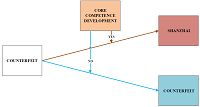The Emergence and Growth Path of Shanzhai Firms
DOI:
https://doi.org/10.46604/peti.2020.4064Keywords:
shanzhai, emerging economies, growth strategies, counterfeitsAbstract
Shanzhai refers to a set of dynamic strategies for firms to grow out of counterfeiting. Shanzhai firms have traditionally been perceived as counterfeiters from the emerging economies producing cheap and low-quality products. This trend has changed in recent years when Shanzhai firms have grown into market leaders and have introduced leading technologies and applications. This paper focuses on the growth of Shanzhai firms by exploring how Shanzhai firms and Shanzhai industries emerged. We further investigate the context that supports the emergence of Shanzhai firms into market leaders. We leverage two case studies using the growth path of two market leaders in their respective industries to illustrate the two paths leading to the emergence of Shanzhai firms. We attempt to show that although Shanzhai firms start out with low legitimacy, these firms grow their legitimacy over time by building their core competitiveness in their respective industries.
References
B. Berman, “Strategies to detect and reduce counterfeiting activity,” Business Horizons, vol. 51, no. 3, pp. 191-199, 2008.
K. K. Y. Lai and J. L. Zaichkowsky, “Brand imitation: do the Chinese have different views?” Asia Pacific Journal of Management, vol. 16, no. 2, pp. 179-192, August 1999.
K. Rong, Z. Liu, and Y. Shi, “Reshaping the business ecosystem in China: case studies and implications,” Journal of Science and Technology Policy in China, vol. 2, no. 2, pp. 171-192, 2011.
M. W. Peng and P. S. Heath, “The growth of the firm in planned economies in transition: institutions, organizations, and strategic choice,” Academy of management review, vol. 21, no. 2, pp. 492-528, April 1996.
Y. Hu, “Why Shanzhai mobile phones thrive?” Management & Technology of SME, vol. 18, pp. 13-114, 2009.
M. Treleven and S. B. Schweikhart, “A risk/benefit analysis of sourcing strategies: single vs. multiple sourcing,” Journal of operations management, vol. 7, no. 4, pp. 93-114, December 1988.
T. Staake, F. Thiesse, and E. Fleisch, “Business strategies in the counterfeit market,” Journal of Business Research, vol. 65, no. 5, pp. 658-665, 2012.
X. Liu, Y. Xie, and M. Wu, “How latecomers innovate through technology modularization: evidence from China’s Shanzhai industry,” Innovation, vol. 17, no. 2, pp. 266-280, 2015.
J. Chen, K. G. Chang, and Y. S. Su, “Innovation management: winning competitive advantage in the globe,” Taipei, Taiwan: Best-Wise Publishing, 2015.
X. Liu, Y. Wu, and G. Lai, “Strategic transformation of Shanzhai firms: evidence from a Chinese case,” International Journal of Technology, Policy and Management, vol. 15, no. 1, pp. 77-94, 2015.
F. Kodama, “Measuring emerging categories of innovation: modularity and business model,” Technological Forecasting and Social Change, vol. 71, no. 6, pp. 623-633, 2004.
J. K. Gershenson, G. J. Prasad, and Y. Zhang, “Product modularity: definitions and benefits,” Journal of Engineering Design, vol. 14, no. 3, pp. 295-313, 2003.
D. Campagnolo and A. Camuffo, “The concept of modularity in management studies: a literature review,” International Journal of Management Reviews, vol. 12, no. 3, pp. 259-283, 2010.
C. Y. Baldwin and K. B. Clark, “Managing in an age of modularity,” Managing in the modular age: architectures, networks, and organizations, pp. 84-93, 2003.
R. N. Langlois, “External economies and economic progress: the case of the microcomputer industry,” Business history review, vol. 66, no. 1, pp. 1-50, 1992.
J. Zhou, Y. Tong, and J. Li, “Disruptive innovation for the base of the pyramid market: a case study on China’s Shanzhai cell phone industry,” International Journal of Innovation and Sustainable Development, vol. 6, no. 4, pp. 392-419, 2012.
C. Y. Baldwin and K. B. Clark, “Design rules: the power of modularity,” Cambridge, MA: MIT Press, vol. 1, 2000.
C. K. Lee and S. C. Hung, “Institutional entrepreneurship in the informal economy: China's shan‐zhai mobile phones,” Strategic Entrepreneurship Journal, vol. 8, no. 1, pp. 16-36, 2014.
S. Zhu and Y. Shi, “Shanzhai manufacturing: an alternative innovation phenomenon in China: its value chain and implications for Chinese science and technology policies,” Journal of Science and Technology Policy in China, vol. 1, no. 1, pp. 29-49, 2010.
M. A. Schilling and H. K. Steensma, “The use of modular organizational forms: an industry-level analysis,” Academy of management journal, vol. 44, no. 6, pp. 1149-1168, 2001.
M. G. Harvey and I. A. Ronkainen, “International counterfeiters-marketing success without the cost and the risk,” Columbia Journal of World Business, vol. 20, no. 3, pp. 37-45, 1985.
A. Shilov, “AMD: Development of Zen CPUs is our largest R&D spending now,” https://www.kitguru.net/components/cpu/anton-shilov/amd-development-of-zen-process or-is-our-largest-rd-spending-now/, June 2017.
H. L. Chen, “Xiaomi joins Apple and Samsung, developing its own processors,” https://http://www.ithome.com.tw/news/112404, June 2017.
J. Mitra and S. Chunlin, “Innovation, entrepreneurship, and governance: the Shanzhai handset business,” ICSB World Conference Proceedings, International Council for Small Business (ICSB), January 2010, p. 1.
S. ADAMS, “Mark Zuckerberg regrets not learning from WeChat sooner,” https://radiichina.com/mark-zuckerberg-regrets-not-learning-from-wechat-sooner/, March 2019.
N. Statt and S. Liao, “Facebook wants to be WeChat,” https://www.theverge.com/2019/3/8/18256226/facebook-wechat-messaging-zuckerberg-strategy, March 2019.
I. Deng, “Facebook is changing, and this Chinese app is the model,” https://www.inkstonenews.com/tech/zuckerberg-regrets-not-learning-wechat-facebook-turns-private-chats/article/3001218, 2019, March 2019.
M. W. Peng, D. Ahlstrom, S. M. Carraher, and W. S. Shi, “An institution-based view of global IPR history,” Journal of International Business Studies, pp. 1-15, 2017.

Published
How to Cite
Issue
Section
License
Submission of a manuscript implies: that the work described has not been published before that it is not under consideration for publication elsewhere; that if and when the manuscript is accepted for publication. Authors can retain copyright of their article with no restrictions. Also, author can post the final, peer-reviewed manuscript version (postprint) to any repository or website.

Since Oct. 01, 2015, PETI will publish new articles with Creative Commons Attribution Non-Commercial License, under The Creative Commons Attribution Non-Commercial 4.0 International (CC BY-NC 4.0) License.
The Creative Commons Attribution Non-Commercial (CC-BY-NC) License permits use, distribution and reproduction in any medium, provided the original work is properly cited and is not used for commercial purposes







